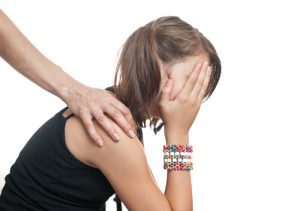10 Self-Esteem Problems in Teenagers

A great variety of physical and psychological changes happen in one of the stages most parents fear: adolescence. With these changes, there are usually a number of situations that must be handled very well. One of the most sensitive matters is self-esteem problems in teenagers.
Self-esteem has an important role during adolescence, a phase in which self-identity is formed. The way that teenagers value themselves will greatly determine their relationships with others, and the way they face life.
Self-esteem Problems in Teenagers
- Difficulty to maintain relationships with others: not accepting and not valuing themselves makes it difficult to maintain healthy relationships with others.
- Depression: young people with low self-esteem have a bigger tendency to suffer from depression. They don’t accept themselves and as a result, they think others won’t accept them as they are.
- Academic problems: poor academic performance can sometimes be caused by low self-esteem problems in teenagers. Believing they aren’t capable of learning becomes an obstacle.
- Difficulty to express their feelings: when young people feel inferior to others, they have the idea that whatever they feel, no matter how important or serious it is, will mean nothing for those around them.

- Eating disorders: wanting to be liked and accepted can lead to wanting to achieve an ideal appearance. Anorexia is a serious consequence that can be caused by this obsession to achieve a certain look.
- Low motivation: teenagers with self-esteem problems are apathetic and have a lack of interest in doing things. They don’t try because of their constant fear of not meeting others’ expectations.
- Abuse: many teenagers with low self-esteem can be victims of abuse and mistreatment. They let others mistreat them because they’re afraid of showing their position and being rejected.
The way that teenagers see themselves will greatly affective their relationships with others, and the way they face life.
- Rebellion: wanting to be accepted by a group, teenagers can resort to violent or illegal actions, even when they know that what they’re doing isn’t right.
- Dependency: teenagers with a poor self-image will have trouble to become independent. This happens because they convince themselves that they aren’t capable of achieving anything without help.
- Lack of future plans: when teenagers don’t believe in their abilities, they’ll be less likely to contemplate future personal plans. Their main obstacle is their fear of failure.
What triggers self-esteem problems in teenagers?
We can find the main triggers for self-esteem problems in teenagers within the family, the school and the media.
A family environment that is too critical can be a factor that negatively affects young people’s self-esteem.
Ideally, teens should have a family environment in which they feel understood and accepted. A nourishing and affective environment can have a positive impact when building a good self-esteem.

At school, bullying is one of the main causes of low self-esteem. Being a constant target of mockery and criticism has a negative effect on teenagers, especially on those who are highly sensitive.
Ideally, teens should have a family environment in which they feel understood and accepted.
Likewise, all the false images of perfection shown by the media have a terrible effect on young people. Wanting to imitate their idols and not succeeding causes poor self-esteem in many teenagers.
Family should be the main source of support for teenagers with self-esteem problems.
Permanent communication and supervision are fundamental elements to help them within the family. Reinforcing their virtues, highlighting their achievements, understanding their challenges and filling them with confidence and trust are all very important actions at this stage in life.
When families don’t succeed in helping adolescents overcome their self-esteem problems, the best thing is to seek professional help.
All cited sources were thoroughly reviewed by our team to ensure their quality, reliability, currency, and validity. The bibliography of this article was considered reliable and of academic or scientific accuracy.
- Casado, I. (2013). Adolescencia. FMC – Formación Médica Continuada En Atención Primaria. https://doi.org/10.1016/s1134-2072(04)75726-6
- Granados Díaz, A. M. (2018). Las relaciones tóxicas de pareja en adolescentes: Factores de riesgo y protección. https://repositorio.comillas.edu/xmlui/handle/11531/23129
- Iglesias Diz, J. L. (2013). Desarrollo del adolescente: Aspectos físicos, psicológicos y sociales. Pediatria Integral.
- Hurlock, E. (1995). Psicología de la adolescencia. Psicología de la adolescencia.
-
Mulsow, G. (1998). Desarrollo humano: ciclo vital y educación. Educación, 7(13), 61-73. https://dialnet.unirioja.es/descarga/articulo/5056780.pdf
- Naranjo, C. R., & González, A. C. (2012). Autoestima en la adolescencia: Análisis y estrategias de intervención. International Journal of Psychology and Psychological Therapy.
- Roa, A. (1982). La adolescencia. Revista Chilena de Pediatria.
- Silva-Escorcia, I., & Mejía-Pérez, O. (2014). Autoestima, adolescencia y pedagogía. Revista Electrónica Educare. https://doi.org/10.15359/ree.19-1.13
- Y LLEGÓ LA ADOLESCENCIA Guía para Padres y Madres con hijos e hijas adolescentes. https://www.adolescenciasema.org/ficheros/padres/y-llego-la-adolescencia.pdf
- Rengifo-Macías, M. C., & Morales-Intriago, J. C. (2019). Modelo de intervención para mejorar la aceptación social en adolescentes. Polo del conocimiento, 4(8), 190-202. Disponible en este enlace.
- Villarreal González, M. E., Sánchez Sosa, J. C., & Musitu Ochoa, G. (2010). Cómo mejorar tus habilidades sociales. Programa para adolescentes: manejo del estrés, resolución de problemas, autoestima, asertividad, proyecto de vida y administración del tiempo libre. http://eprints.uanl.mx/8472/1/v9_1.pdf
This text is provided for informational purposes only and does not replace consultation with a professional. If in doubt, consult your specialist.








